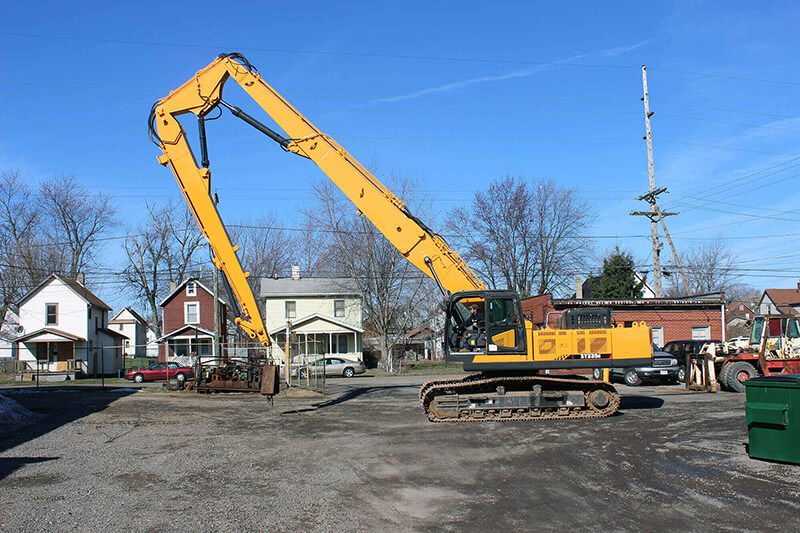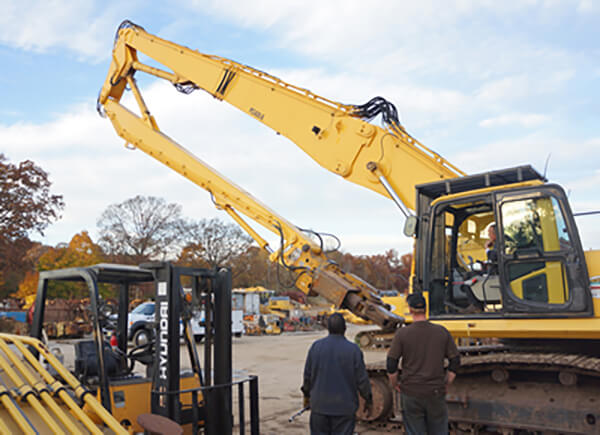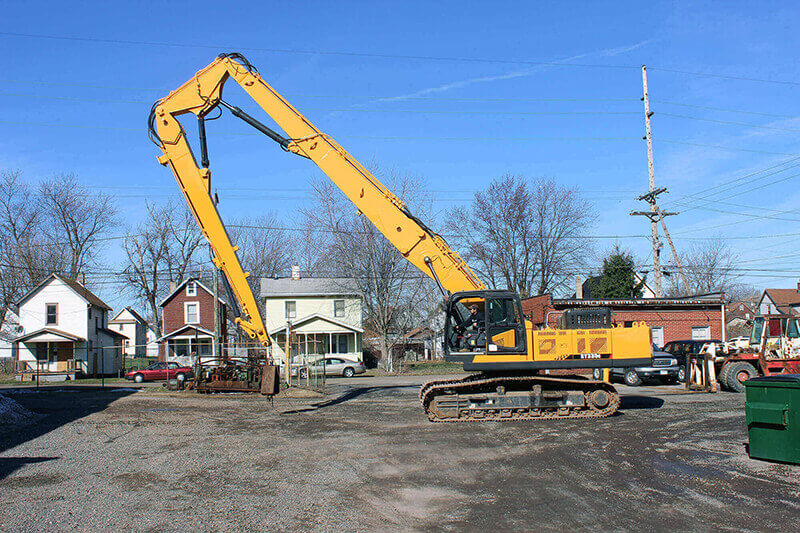 HuiTong
HuiTong  2025-06-13
2025-06-13
When it comes to demolishing structures, the excavator demolition arm stands as a towering force capable of tearing through concrete and steel with remarkable precision. This mechanical marvel, often seen in action on construction sites or in the aftermath of natural disasters, has become an iconic symbol of power and efficiency. In this article, we will delve into the fascinating world of the excavator demolition arm, exploring its design, technology, and the remarkable engineering behind its ability to bring down towering structures.

The excavator demolition arm, also known as a wrecking ball or a high-reach excavator, is a specialized attachment designed for heavy-duty demolition tasks. It consists of a long steel arm mounted on an excavator base, which can be rotated and maneuvered with hydraulic controls. At the end of the arm, a wrecking ball, shear, or pulverizer is attached, depending on the specific task at hand.
The arm's immense size and strength are essential for its purpose. It is often built to be longer than the standard excavation arm, allowing for greater reach and height capabilities. Reinforced with high-grade steel and supported by a robust hydraulic system, the demolition arm can withstand the extreme forces exerted during demolitions.
The excavator demolition arm operates on hydraulic power, which provides the force required to carry out precise and controlled demolition tasks. Hydraulic cylinders, powered by the excavator's engine, generate immense pressure to control the arm's movements and deliver crushing blows.
The arm's flexibility and accuracy are attributed to its hydraulic system. By adjusting the flow of hydraulic fluid to the cylinders, the operator can manipulate the arm's motion, making it swing, rotate, extend, and retract. This versatility allows for careful positioning of the demolition tool to deliver forceful strikes precisely where needed.
Different demolition tools can be attached to the arm, depending on the task's requirements. A wrecking ball, for instance, is ideal for larger structures and utilizes the kinetic energy gained from its swinging motion to pulverize the target. On the other hand, shears or pulverizers are used when precise cutting or crushing is necessary, such as when demolishing reinforced concrete or steel beams.

Safety is of paramount importance when operating an excavator demolition arm. Modern machines are equipped with various safety features, including operator cabins with reinforced glass and protective structures to shield the operator from falling debris. Additionally, advanced control systems and sensors ensure stability and prevent overloading, enhancing the safety of both the operator and the surrounding environment.
Technological advancements have further improved the efficiency and precision of these demolition arms. Some models now feature automated systems that use sensors and cameras to assist the operator in positioning the arm accurately and avoiding potential hazards. These technologies enhance productivity while reducing the risk of accidents and minimizing damage to surrounding structures.
The excavator demolition arm stands as a testament to human engineering and ingenuity, showcasing the remarkable capabilities of modern construction equipment. Its immense power, coupled with advanced hydraulic systems and safety features, allows for the precise and controlled destruction of structures with unparalleled efficiency. As we continue to advance technologically, we can expect further enhancements in the field of demolition, pushing the boundaries of what these mechanical giants can achieve.
As technology continues to evolve, the future of excavator demolition arm looks promising. Engineers and manufacturers are constantly pushing the boundaries to enhance their capabilities, making them even more efficient, precise, and safe.
One area of ongoing development is the integration of advanced robotics and artificial intelligence (AI) into these demolition arms. AI algorithms can analyze structural data and assist in planning demolitions, optimizing the sequence of strikes for maximum efficiency while minimizing collateral damage. Robotic arms equipped with AI can also adapt to changing conditions in real-time, making adjustments to their movements and force application for improved accuracy.
Another area of focus is the development of alternative power sources. While most excavator demolition arms currently rely on diesel engines, there is a growing interest in exploring greener alternatives such as electric or hybrid systems. These advancements not only reduce emissions and environmental impact but also offer the potential for quieter operation and increased energy efficiency.
Furthermore, advancements in materials science are paving the way for stronger and lighter construction materials, leading to the development of more agile and powerful demolition arms. Composite materials, such as carbon fiber reinforced polymers, offer high strength-to-weight ratios, enabling the creation of longer, more maneuverable arms without sacrificing structural integrity.
The excavator demolition arm has become an emblem of power and efficiency in the world of construction and demolition. Through advanced engineering and hydraulic systems, these mechanical giants can bring down towering structures with precision and control. As technology progresses, we can expect even more innovative advancements in the field, incorporating robotics, AI, alternative power sources, and advanced materials. With each new development, the excavator demolition arm will continue to shape the landscape of demolition, revolutionizing the way we approach the challenging task of tearing down structures while ensuring safety, efficiency, and sustainability.

Excavator demolition arms have a significant impact on society beyond their impressive capabilities. They play a crucial role in urban development, infrastructure renewal, and disaster recovery. By efficiently demolishing old structures, these machines make way for new construction projects, revitalizing cities and improving quality of life.
In urban areas, where space is limited, the precise demolition capabilities of these arms are invaluable. They allow for the selective dismantling of structures, minimizing disruption to surrounding buildings and infrastructure. This targeted approach helps preserve historical landmarks, protect adjacent properties, and reduce the environmental impact of demolition.
During disaster recovery efforts, excavator demolition arms become vital tools in clearing debris and making areas accessible for rescue and rebuilding. Their strength and agility enable them to navigate through collapsed structures, aiding in search and rescue missions while ensuring the safety of emergency responders.
Moreover, the efficiency of excavator demolition arm helps reduce project timelines and costs. By streamlining the demolition process, construction projects can commence sooner, leading to faster economic development and job creation. Additionally, the ability to salvage and recycle materials from demolished structures promotes sustainability and reduces waste.
However, it is important to address the potential environmental impact of demolitions. Dust, noise, and emissions generated during the process can have adverse effects on air quality and the well-being of nearby communities. As a result, strict regulations and best practices are in place to mitigate these concerns and ensure that demolitions are carried out in an environmentally responsible manner.
In conclusion, excavator demolition arm have a significant societal impact. They contribute to urban development, disaster recovery, and economic growth. By efficiently and precisely demolishing structures, these machines shape the landscape and pave the way for progress. As technology and environmental considerations continue to evolve, the responsible use of excavator demolition arms will be paramount in achieving sustainable and resilient cities for future generations.